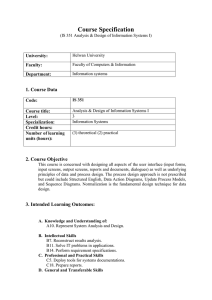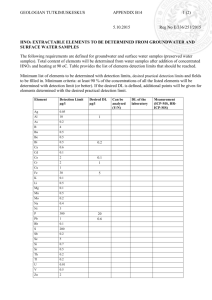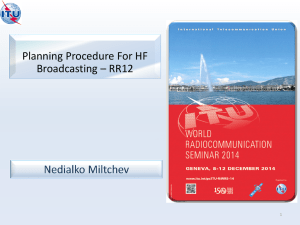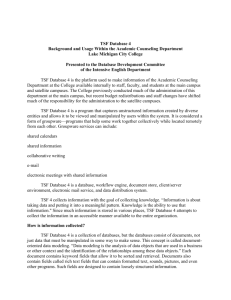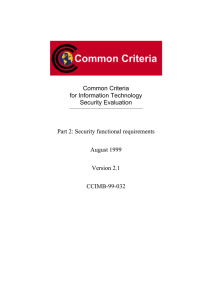1.364 ADVANCED GEOTECHNICAL ENGINEERING FALL SEMESTER 2003 HOMEWORK NO.2 Due: Friday October 10
advertisement
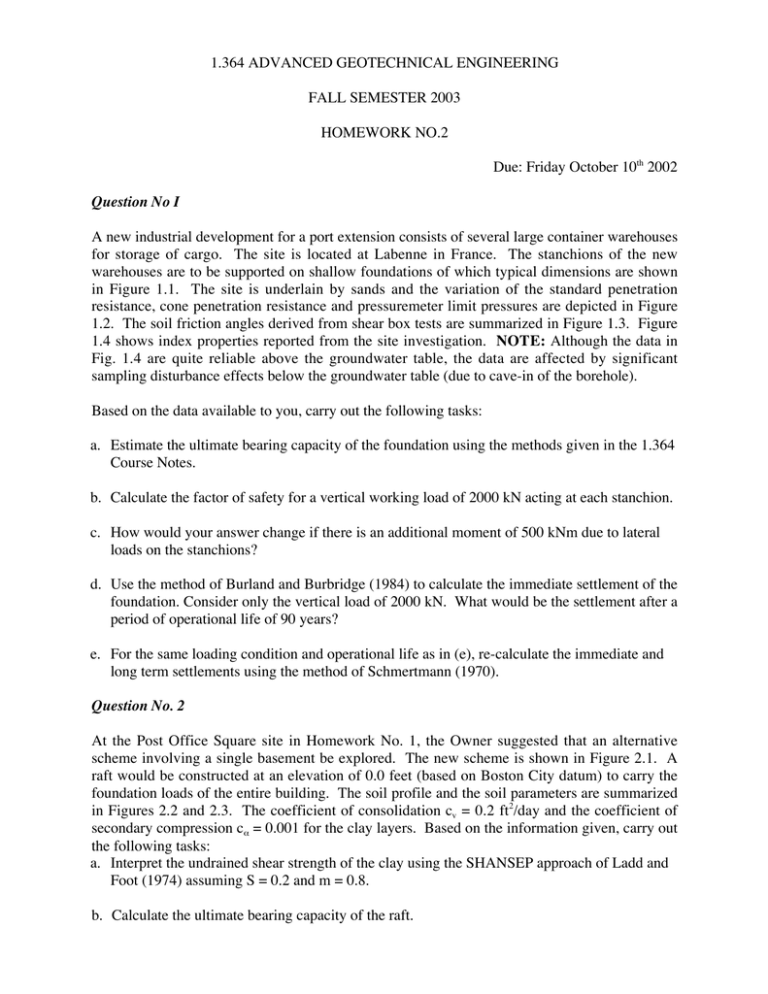
1.364 ADVANCED GEOTECHNICAL ENGINEERING FALL SEMESTER 2003 HOMEWORK NO.2 Due: Friday October 10th 2002 Question No I A new industrial development for a port extension consists of several large container warehouses for storage of cargo. The site is located at Labenne in France. The stanchions of the new warehouses are to be supported on shallow foundations of which typical dimensions are shown in Figure 1.1. The site is underlain by sands and the variation of the standard penetration resistance, cone penetration resistance and pressuremeter limit pressures are depicted in Figure 1.2. The soil friction angles derived from shear box tests are summarized in Figure 1.3. Figure 1.4 shows index properties reported from the site investigation. NOTE: Although the data in Fig. 1.4 are quite reliable above the groundwater table, the data are affected by significant sampling disturbance effects below the groundwater table (due to cave-in of the borehole). Based on the data available to you, carry out the following tasks: a. Estimate the ultimate bearing capacity of the foundation using the methods given in the 1.364 Course Notes. b. Calculate the factor of safety for a vertical working load of 2000 kN acting at each stanchion. c. How would your answer change if there is an additional moment of 500 kNm due to lateral loads on the stanchions? d. Use the method of Burland and Burbridge (1984) to calculate the immediate settlement of the foundation. Consider only the vertical load of 2000 kN. What would be the settlement after a period of operational life of 90 years? e. For the same loading condition and operational life as in (e), re-calculate the immediate and long term settlements using the method of Schmertmann (1970). Question No. 2 At the Post Office Square site in Homework No. 1, the Owner suggested that an alternative scheme involving a single basement be explored. The new scheme is shown in Figure 2.1. A raft would be constructed at an elevation of 0.0 feet (based on Boston City datum) to carry the foundation loads of the entire building. The soil profile and the soil parameters are summarized in Figures 2.2 and 2.3. The coefficient of consolidation cv = 0.2 ft2/day and the coefficient of secondary compression ca = 0.001 for the clay layers. Based on the information given, carry out the following tasks: a. Interpret the undrained shear strength of the clay using the SHANSEP approach of Ladd and Foot (1974) assuming S = 0.2 and m = 0.8. b. Calculate the ultimate bearing capacity of the raft. c. If a factor of safety of 2.0 is required by the local Building Authority, how many floors can the building be designed to, if the working live load is 0. 1 tsf per floor and 0.2 tsf for the basement. Assume the structural dead load to be 0.5 tsf per floor and 0.36 tsf for the basement. After much discussion, a 13 storey high structure with a single basement was chosen. For this case: d. Calculate the immediate settlement using the method of D'Appoloniaet al (1971). Assume K0 = K0NC (OCR)n, where K0NC = 0.5 and n = 0.4. e. Estimate the consolidation settlement assuming that the loads are applied instantaneously. f. Estimate the long term creep settlement for a design life of 90 years. g. If the actual construction period is 12 months, what amount of settlement can be expected after the end of construction for the same design life? 500 kNm 500 kN 2000 kN 2000 kN 1.5m 1.5 m 20 m 20 m 2m 10 m 5m Figure 1.1 Foundation layout 3m 0 0 4 5 6 6 0 50 100 1.0 2.0 Menard 12.7% organic content 13 5 Pressiopenetrometer 2 Fine-medium light brown uniform sand 7 Borehole log CPT qc (MPa) SPT blows / 300 mm Pressuremeter CPT fc (kPa) limit pressure pL (MPa) Figure 1.2. Insitu Test Data 100 Dr (%) 75 50 25 45 fp 40 Angle of friction (f ) Depth (m) Some clay traces 2 3 4 15 1 GWL 2 35 fcv ; 33o LEGEND Shear box data: Soil-soil, peak Conditions at constant volume 30 25 0.45 0.50 0.55 0.60 0.65 0.70 Initial voids ratio ei Figure 1.3. Soil Friction Angle Obtained from Shear Box Tests Water content 0 0 2 2 Depth (m) Depth (m) Bulk density 4 6 4 6 Yb (kN/m3) 15 w (%) 20 0 10 0 0 2 2 Depth (m) Depth (m) 100 6 30 Relative density Sr - Degree of saturation 4 20 Dr (%) 50 0 4 6 Sr (%) 0 50 e 100 0.4 0.6 Void ratio 0.8 LEGEND BH IC 1 BH IC 2 Open symbols : average of complete sample 'Organic' sand Figure1.4. Physical Properties obtained from Laboratory Tests Pore Water Pressure, uo, u (TSF) 20 1.0 0.5 1.5 2.0 2.5 0 10 20 30 40 50 60 FILL 0 U-1 PZ 11A U-1 U-1 -10 uo U-2 -20 CLAY U-2 PZ 11B U-3 U-3 Hydrostatic Pore Water Pressure (Assuming Water Level at EL. = 9.0 -30 U-4 -40 -60 -70 TILL -50 u PZ 1(A) ROCK Elevation in Feet (Boston City Base) 10 0 Natural Water Content, Atterberg Limits (Percent) PZ 1(B) B1 PZ 3(B) B2 B3 PZ 12 PZ 14 B11 B12 B14 Observed in-situ pore water pressure Symbol OB. Well No. Plastic Limit, Wp Symbol Boring No. Piez. No. B2 B1 PZ1(A) B3 B1 PZ1(B) B3 B11 PZ3(A) PZ3(B) PZ11(A) B12 B11 PZ11(B) B14 B12 PZ12 B14 PZ14 B9 B11 B3 Liquid Limit, WL Natural Water Content, WN Origin of Data: Postoffice SQ. Garage One Post office SQ. (H & A File No. 4207) Figure 2.2. Pore water pressures, natural water content and Atterberg Limits Vertical Effective Stress, σvo, σv, σp (TSF) Compressibility Parameters, CR, RR 20 10 FILL 0 0 U-1 6.0 8.0 Best Estimate of σp' Preconsolidation Pressure U-1 -10 σv - Vertical Effective U-2 Stress (Based on observed in-situ pore water pressure) CLAY U-2 PZ 11B U-3 U-3 -30 U-4 -40 -60 -70 TILL RR CR -50 10.0 CR PZ 11A U-1 ROCK Elevation in Feet (Boston City Base) 4.0 Mean RR -20 2.0 PZ 3(B) PZ 1(A) PZ 12 0.01 0.1 0.02 0.2 0.03 0.04 0.3 0.4 PZ 14 Compression Ratio, CR PZ 1(B) B1 0 0 Recompression Ratio, RR B2 B3 B11 B12 B14 σ vo -Vertical Effective Stress (Assuming Water Level @ EL. 9.0) Symbol Boring Sample B2 B2 B12 U2 U4 U3 B14 U1 B2 U1 B2 B12 U3 U1 B14 U2 Figure 2.3. Compressibility parameters and vertical effective stress

